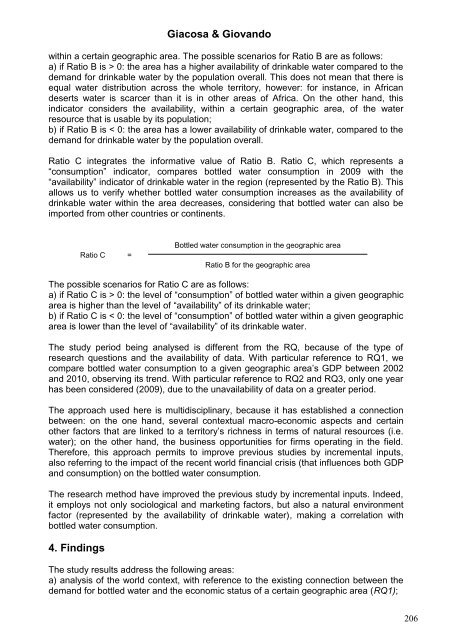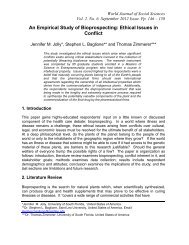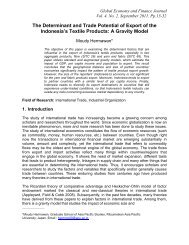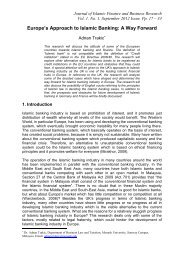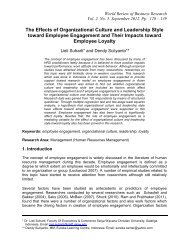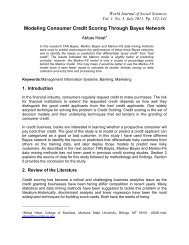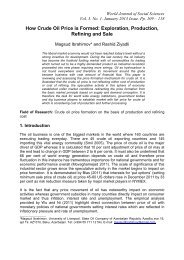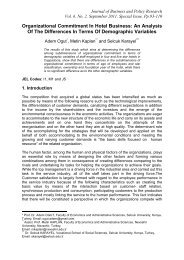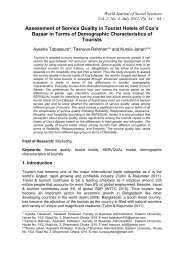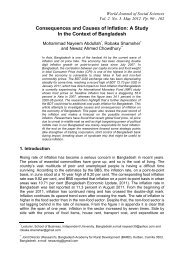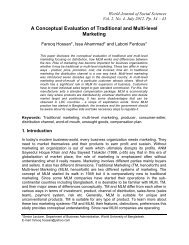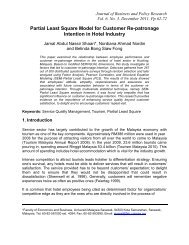Bottled Water Consumption: The Case of Italy - Wbiaus.org
Bottled Water Consumption: The Case of Italy - Wbiaus.org
Bottled Water Consumption: The Case of Italy - Wbiaus.org
You also want an ePaper? Increase the reach of your titles
YUMPU automatically turns print PDFs into web optimized ePapers that Google loves.
Giacosa & Giovandowithin a certain geographic area. <strong>The</strong> possible scenarios for Ratio B are as follows:a) if Ratio B is > 0: the area has a higher availability <strong>of</strong> drinkable water compared to thedemand for drinkable water by the population overall. This does not mean that there isequal water distribution across the whole territory, however: for instance, in Africandeserts water is scarcer than it is in other areas <strong>of</strong> Africa. On the other hand, thisindicator considers the availability, within a certain geographic area, <strong>of</strong> the waterresource that is usable by its population;b) if Ratio B is < 0: the area has a lower availability <strong>of</strong> drinkable water, compared to thedemand for drinkable water by the population overall.Ratio C integrates the informative value <strong>of</strong> Ratio B. Ratio C, which represents a“consumption” indicator, compares bottled water consumption in 2009 with the“availability” indicator <strong>of</strong> drinkable water in the region (represented by the Ratio B). Thisallows us to verify whether bottled water consumption increases as the availability <strong>of</strong>drinkable water within the area decreases, considering that bottled water can also beimported from other countries or continents.Ratio C =<strong>Bottled</strong> water consumption in the geographic areaRatio B for the geographic area<strong>The</strong> possible scenarios for Ratio C are as follows:a) if Ratio C is > 0: the level <strong>of</strong> “consumption” <strong>of</strong> bottled water within a given geographicarea is higher than the level <strong>of</strong> “availability” <strong>of</strong> its drinkable water;b) if Ratio C is < 0: the level <strong>of</strong> “consumption” <strong>of</strong> bottled water within a given geographicarea is lower than the level <strong>of</strong> “availability” <strong>of</strong> its drinkable water.<strong>The</strong> study period being analysed is different from the RQ, because <strong>of</strong> the type <strong>of</strong>research questions and the availability <strong>of</strong> data. With particular reference to RQ1, wecompare bottled water consumption to a given geographic area’s GDP between 2002and 2010, observing its trend. With particular reference to RQ2 and RQ3, only one yearhas been considered (2009), due to the unavailability <strong>of</strong> data on a greater period.<strong>The</strong> approach used here is multidisciplinary, because it has established a connectionbetween: on the one hand, several contextual macro-economic aspects and certainother factors that are linked to a territory’s richness in terms <strong>of</strong> natural resources (i.e.water); on the other hand, the business opportunities for firms operating in the field.<strong>The</strong>refore, this approach permits to improve previous studies by incremental inputs,also referring to the impact <strong>of</strong> the recent world financial crisis (that influences both GDPand consumption) on the bottled water consumption.<strong>The</strong> research method have improved the previous study by incremental inputs. Indeed,it employs not only sociological and marketing factors, but also a natural environmentfactor (represented by the availability <strong>of</strong> drinkable water), making a correlation withbottled water consumption.4. Findings<strong>The</strong> study results address the following areas:a) analysis <strong>of</strong> the world context, with reference to the existing connection between thedemand for bottled water and the economic status <strong>of</strong> a certain geographic area (RQ1);206


